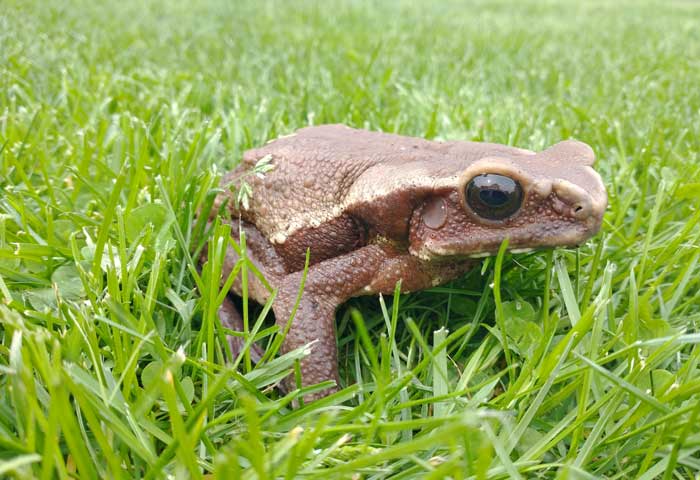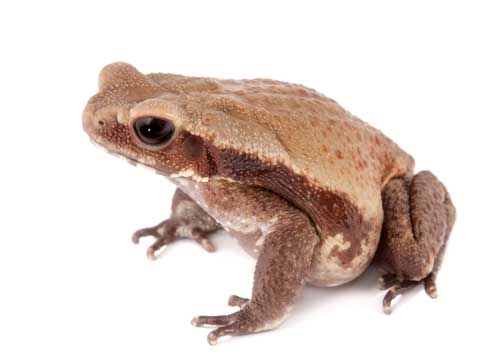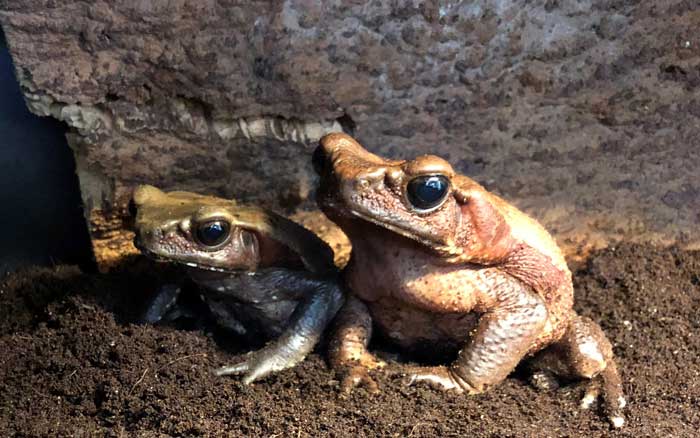As its name suggests, the smooth-sided toad (Rhaebo guttatus) has smooth skin and lacks distinct warts present in most toads. This toad species is large, with individuals reaching up to 9 inches.
It is native to South America and inhabits the tropical forests of northern South America. Its range extends over many different countries including Colombia, Ecuador, French Guiana, Guyana, Suriname, Brazil, and Venezuela.
In this article, we’ll discuss everything you need to know about this enigmatic species of South America. You’ll discover its key aspects such as size, poison characteristics, diet, habitat, and lifespan.
Moreover, we will cover helpful care tips for this toad if you’re interested in keeping it as a pet.
An Overview of the Smooth-sided Toad:
The smooth-sided toad (Rhaebo guttatus) is also known as a smooth toad or spotted toad. It was formerly known as Bufo guttaus, before its scientific name transited to Rhaebo guttatus.
Nevertheless, this species is considered a true toad and falls under the family Bufonidae.
This toad is easily identified by light brown to reddish brown dorsal coloration while the underside has a darker shade. It also features a quite prominent periocular ridge present even in juveniles.
As mentioned above, this toad is native to South America, with its geographic range extending over many countries. These include Brazil, Ecuador, Suriname, French Guiana, Guyana, Colombia, Peru, Venezuela, and Bolivia.
Its natural habitat includes the tropical moist lowland forests, the mature gallery forests in particular. It is found in deep leaf litter or on the ground on the forest floor. The toad occurs at elevations ranging from 50 to 860 m above sea level.

Adult smooth-sided toads can grow quite large, up to 9 inches (23 cm). The toad exhibits sexual dimorphism, where the females appear larger than males.
The toad can grow active both day and at night and feeds on insects as well as small invertebrates.
For the mating part, this toad has been observed to breed in temporary and permanent water bodies, including puddles and swampy areas. Males usually gather around the breeding sites and start calling from the edges of the waterbody to attract females for mating.
A single female can lay up to 10,000 eggs per clutch. These are deposited in the waters and take around 10 days to hatch. Tadpoles take approx. 3 months to metamorphose into adults. (Source).
Like most other toad species, this smooth toad also features parotid glands behind its eyes, which secretes a milky white substance containing toxins. This acts as its defense mechanism against predators and can even cause heart failure in humans if ingested.
The current conservation status for this toad on the IUCN Red List is “Least Concern”. This means the species population is found in plenty in the wild and is at low risk of extinction.
However, it is worth keeping in mind that this toad faces the local threat of habitat loss.
Smooth-sided Toad Size
An adult male grows to about 5.9 (15cm) long from snout to vent. List most toad species, females tend to outgrow the males and can reach up to 6.9 inches (17.4 cm) in size and possibly up to 9 inches (23cm) or more.

Smooth-sided Toad Poison
Similar to most toad species, the smooth-sided toad features toxin glands (parotid glands) situated right behind its eyes. These produce a milky white substance containing toxins known as bufotoxins, which act as the species’ main line of defense against potential predators.
Note that this toxic substance is quite potent and can even cause heart failure in humans. Though captive-bred toads are said to be a little bit hesitant to produce these toxins, we still advise you to exercise caution when handling your toad pet to avoid coming into contact with this toxin.
Smooth-sided Toad Diet
Smooth-sided toad diet consists of insects and even small mammals. Since these are large species, they can eat large food types and the adults will easily consume adult cockroaches and crickets.

Other food types fed to these toads in captivity include mealworms, earthworms, hornworms, silkworms, waxworms, dubia roaches, phoenix worms, and even crayfish. An occasional mouse is also okay for this toad.
Smooth-sided Toad Lifespan
There isn’t enough data regarding the average lifespan of smooth toads in the wild. The smooth-sided toad has a lifespan of up to 10 years or more in captivity. However, this depends on how well you take care of your pet. Providing it with proper care, including a balanced diet, suitable habitat, regular vet checkups, etc., can contribute to its overall well-being.

Smooth-sided Toad Care
If you’re thinking about keeping a smooth-sided toad as a pet, this is your part. In captivity, you’ll need to provide this toad with a spacious and comfortable vivarium that mimics its natural habitat.
Besides, you’ll need to meet all its special requirements to ensure its well-being and enable it to live with you for more years to come.

Here’s our list of smooth-sided toad care tips to keep in mind:
- Enclosure: Since these amphibians are large, they require a large-sized enclosure. We suggest getting a glass terrarium of at least 24x18x18 inches to house an adult. Alternatively, a 20-gallon aquarium will house this toad. If you’re keeping a pair, you’ll need a larger enclosure. Be sure to provide ventilation for your enclosure as these toads can’t tolerate stagnant, moist air for long.
- Substrate recommendation: Use a substrate that mimics the wild habitat of this toad such as ground coconut floor. Still at it, you may consider providing the toad with plenty of décor for climbing and hiding in. Live plants are also recommended to give the enclosure an even more natural feel.
- Temperature: These toads can tolerate temperatures from 65 F to over 85F. However, you should ideally keep them at room temperature ranging from mid to high 70s. Low-wattage basking spot will help you maintain temperature within this safe range.
- Lighting: The use of UVB lighting for UV rays isn’t necessary for toads. However, this toad may benefit from a low-wattage UVB light if you provide it with one.
- Humidity: Smooth side toads can also tolerate a wide range of humidity levels but we recommend an optimal range of 50 to 70%. Make sure you provide them with plenty of ventilation to promote free air movement. Routine spraying of the enclosure will help maintain the humidity at the recommended levels.
- Watering: You’ll also need to provide this toad with a shallow water dish filled with dechlorinated water for soaking/bathing and sometimes hiding.
- Feeding: We recommend feeding your smooth toad pet every other day. Feed them a good mixture of commercially available live insect foods such as crickets, roaches, earthworms, locusts, waxworms, etc. Remember to dust their food with good quality amphibian mineral and multivitamin supplements.
- Daily enclosure maintenance: This includes misting the enclosure and spot cleaning. Clean the water dish thoroughly every day and replace the water inside to ensure hygienic conditions inside the enclosure.
A few more things to note about this pet is that it is ideal for beginner to intermediate care levels. It’s also one of the largest toad species and it does well in groups and is generally not aggressive towards each other. However, it can be a bit challenging to breed.
Check out the following video on pet smooth-sided toad care:
Video:
What to do If Your Smooth-sided Toad is Sick
If your smooth-sided toad falls sick or shows any abnormal behavior or distress, then we advise you to consult a vet experienced with amphibian care for proper diagnosis and treatment.
Some of the key signs of a sick pet toad include lethargy, abnormal posture, change in skin color, loss of appetite, weight loss, breathing problems, and cloudy eyes.
Potential causes for these signs of illness in your pet toad include incorrect humidity and/or temperature in its enclosure and exposure to pathogens.
As such, we advise you to quarantine the affected individual to avoid the potential spreading of the disease.
Also, adjust the terrarium conditions to ensure they meet your toad’s specific needs. Adjust the temperature accordingly and keep the enclosure clean.
Smooth-sided Toad Temperature Requirements
Part of proper smooth-sided toad care involves providing it with specific temperature conditions to ensure optimal well-being.
This is important given that this creature is ectothermic and relies on the surrounding temperatures to regulate its body temperature.

The ideal smooth-sided toad temperature is 70 to 80 degrees Fahrenheit (21-27 degrees Celsius). This is crucial for the well-being of the toad including carrying out metabolic functions, digestion, and overall activity.
This temperature range mimics the toad’s natural habitat in the warm South American climates.
Note that too high or too low temperature can adversely affect the toad’s health and impact its physiological processes. This can potentially result in stress and even illness.
Thus, make sure you maintain the temperature inside your smooth toad enclosure at the recommended levels to keep your lovely toad healthy.
Smooth-sided Toad for Sale: Where to Buy
Smooth-sided toads are readily available for purchase for those interested in keeping them as pets.

Some top avenues to consider when looking for a smooth-sided toad for sale include:
- Reputable exotic pet breeders
- Pet stores
- Reptile and amphibian expos
- Online forums and communities where members may offer to sell or trade pets
- Online platforms dedicated to exotic pets
When making a purchase, make sure the seller you buy from adheres to the legal and ethical practices as this shows prioritization of the wellbeing of these toads.
Ensure you only get captive-bred toads as the wild-caught ones can have health issues and conservation implications.
You should also be aware of any local or international regulations regarding the ownership and trade of this species to ensure compliance.
Ensure you understand all the specific care requirements for this toad species, including terrarium conditions, temperature, humidity, and diet.
You should also be ready for responsible ownership of this toad, which includes taking proper care of it.
FAQs:
Smooth-sided toads are poisonous. They feature parotid glands that secrete Bufotoxin, a fatty milky white substance that deters potential predators from consuming them. Though this toxin is generally not harmful to humans, ingesting it can lead to health complications and even heart failure!
Yes, smooth-sided toads make loud calls that are hard to miss. Check out the short clip below to hear how loud a smooth-sided toad can be as a pet in your house.
Video:
Conclusion
The smooth-sided toad (Rhaebo guttatus) sets itself apart from most toad species with its smooth skin that lacks the typical warts present in other toads. It’s also one of the largest species available with individuals growing up to 9 inches. This toad inhabits South America and its range encompasses many different countries in this region. Like most toads, these nocturnal species also release toxins via its skin as a defense against predators.
Smooth toad is a popular species for keeping as a pet even for absolute beginners. If you plan to get this toad, be sure to follow our care guidelines above to ensure you take good care of this toad and keep it happy and healthy at all times. With proper care, this toad can live for up to 10 years or more.

Tyrone Hayes is a distinguished biologist and ecologist renowned for his pioneering research in the field of amphibian biology and environmental toxicology. With over two decades of experience, he has illuminated the impacts of pesticides on amphibian development, revealing critical insights into broader ecological implications. Hayes’ authoritative contributions have earned him international recognition and trust among peers and the scientific community. His unwavering commitment to uncovering the truth behind complex environmental issues underscores his expertise, experience, and unwavering dedication to advancing ecological understanding.
